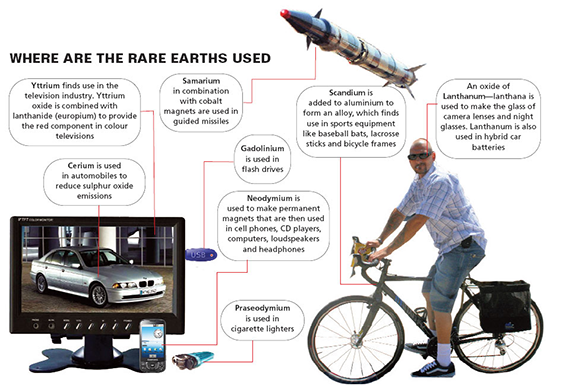Geography
Rare Earth Metals
- 17 Jan 2022
- 6 min read
For Prelims: Rare Earth Metals and its significance
For Mains: Rare Earth Metals, Need to develop capabilities to increase its production in India and steps need to be taken
Why in News
Recently, the US has proposed a law aiming to end China’s alleged “chokehold” on rare-earth metal supplies.
- The Bill aims to “protect the US from the threat of rare-earth element supply disruptions, encourage domestic production of those elements, and reduce its reliance on China.
- The law would require the creation of a “strategic reserve” of rare earth minerals by 2025.
- That reserve would be tasked with responding to the needs of the army, the tech sector and other essential infrastructure “for one year in the event of a supply disruption”.
Key Points
- About:
- They are a set of seventeen metallic elements. These include the fifteen lanthanides on the periodic table in addition to scandium and yttrium that show similar physical and chemical properties to the lanthanides.
- The 17 Rare Earths are cerium (Ce), dysprosium (Dy), erbium (Er), europium (Eu), gadolinium (Gd), holmium (Ho), lanthanum (La), lutetium (Lu), neodymium (Nd), praseodymium (Pr), promethium (Pm), samarium (Sm), scandium (Sc), terbium (Tb), thulium (Tm), ytterbium (Yb), and yttrium (Y).
- These minerals have unique magnetic, luminescent, and electrochemical properties and thus are used in many modern technologies, including consumer electronics, computers and networks, communications, health care, national defense, etc.
- Even futuristic technologies need these REEs (For example high-temperature superconductivity, safe storage and transport of hydrogen for a post-hydrocarbon economy, environmental global warming and energy efficiency issues).
- They are called 'rare earth' because earlier it was difficult to extract them from their oxides forms technologically.
- They occur in many minerals but typically in low concentrations to be refined in an economical manner.
- India's Current Policy on Rare Earths:
- Exploration in India has been conducted by the Bureau of Mines and the Department of Atomic Energy. Mining and processing has been performed by some minor private players in the past, but is today concentrated in the hands of IREL (India) Limited (formerly Indian Rare Earths Limited), a Public Sector Undertaking under the Department of Atomic Energy.
- India has granted government corporations such as IREL a monopoly over the primary mineral that contains REEs: monazite beach sand, found in many coastal states.
- IREL produces rare earth oxides (low-cost, low-reward “upstream processes”), selling these to foreign firms that extract the metals and manufacture end products (high-cost, high-reward “downstream processes”) elsewhere.
- IREL’s focus is to provide thorium — extracted from monazite — to the Department of Atomic Energy.
- China’s Monopoly:
- China has over time acquired global domination of rare earths, even at one point, it produced 90% of the rare earths the world needs.
- Today, however, it has come down to 60% and the remaining is produced by other countries, including the Quad (Australia, India, Japan and United States).
- Since 2010, when China curbed shipments of Rare Earths to Japan, the US, and Europe, production units have come up in Australia, and the US along with smaller units in Asia, Africa, and Latin America.
- Even so, the dominant share of processed Rare Earths lies with China.
- Heavy dependence on China (India and the World):
- India has the world’s fifth-largest reserves of rare earth elements, nearly twice as much as Australia, but it imports most of its rare earth needs in finished form from China.
- In 2019, the US imported 80% of its rare earth minerals from China while the European Union gets 98% of its supply from China.
Way Forward
- India needs to create a new Department for Rare Earths (DRE), which would play the role of a regulator and enabler for businesses in this space.
- Currently, mining and processing has been largely concentrated in the hands of IREL (India) Limited, a PSU under the department of atomic energy.
- Its progress and capacity to produce rare earths, while growing slowly, is nowhere close to international REE conglomerates.
- Indian companies can be encouraged to form such junior exploration businesses in the Indian Ocean Region to prospect for REEs and feed value added products into the Indian market.
- Most governments in this region have mining and exploration friendly policies and welcome investment. India has strong historical, cultural, business and Diaspora links in this region that has developed over centuries of trade and migration.
- India can also coordinate with other agencies to partner directly with groupings such as the Quad, building up a strategic reserve as a buffer against global supply crises.





